E-Mail Edition Volume 12 Number 3
Published Summer, 2015
Published by Piccadilly Books, Ltd., www.piccadillybooks.com.
Bruce Fife, N.D., Publisher, www.coconutresearchcenter.org
If you would like to subscribe to the
Healthy Ways Newsletter
Contents
-
Low-Fat Diets Make You Fat
-
Cures for Nail Fungus
-
There Should Be No Dietary Limit on Fat Intake, Says Researchers
-
New Audiobook Available

Low-Fat Diets
Make You Fat
Low-fat diets promote weight gain
while high-fat diets can help you lose excess weight.
We've been avoiding fat for the
past 3 decades and where has it gotten us? Fat, that's
where! We are fatter now than ever before. Sixty percent
of Americans are now overweight, 30 percent are obese.
It is obvious that the low-fat approach to weight loss
has not worked.
People have lost weight on low-fat
diets, at least initially. You may have had some success
yourself. But where is all that lost weight now? Is it
back on your thighs, hips, and belly? If so, your weight
loss diet hasn't done you a bit of good. If your diet
was successful, truly successful, you should be at or
near your ideal weight right now.
Most people who are overweight have
tried dieting. Many have struggled through numerous
diets, yet they are still overweight. The sad fact is
that low-fat diets don't work. Oh sure, you can lose a
few pounds at first, but over time, the weight comes
right back.
One out of every three people who go on weight loss diets regains their weight within one year. According to the Mayo Clinic, within 5 years 95 percent of those people who go on weight loss diets regain all the weight they lost. That's a 95 percent failure rate! Those 5 percent who do manage to keep the weight off for more than 5 years continue to carefully watch what they eat and are physically active with a regular workout schedule.
Low-fat diets are not only unproductive, they are harmful because they actually cause weight gain! That's right. The low-fat diet you struggled with was actually one of the causes of your weight problem. In addition to regaining your lost weight, you generally end up adding on a few extra pounds as well. You would be better off not having dieted at all. The more times you diet the bigger you get. Doctors have a name for this. It's called diet induced obesity. Low-fat diets are one of the primary causes of our obesity epidemic!
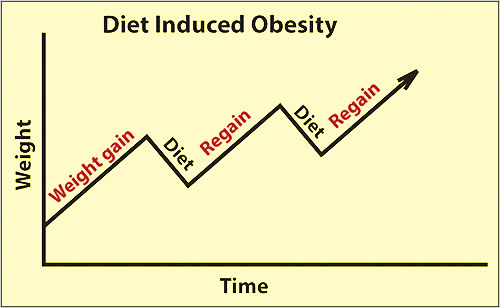
If your weight
is relatively stable, meaning you are not rapidly
gaining or losing weight, the number of calories you consume is about the same
as you are burning off. Even if
you are overweight, your calorie input and output are
fairly equal.
Calories consumed and calories burned are equal, resulting in weight maintenance (no weight gain or loss), see Figure 1. Increasing physical activity will burn off more calories, so we will assume the level of physical activity does not change over time. The first bar represents the number of calories consumed each day. The second bar represents the number of calories use up each day. Since physical activity is held constant,
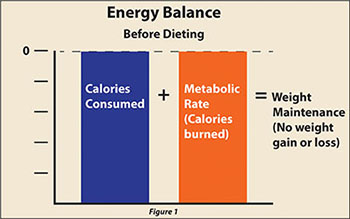
Figure 1
this bar also represents your metabolic rate or the rate at which you burn off calories.
Let's say you start a low-fat, calorie restricted diet by reducing your calorie intake by 200 calories/day (see Figure 2). Since you are now eating fewer calories than you are burning, you experience weight loss. Most people see some positive results when they first start a diet.
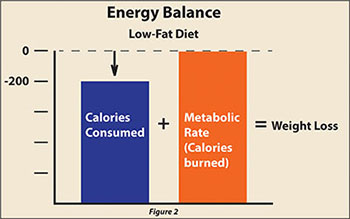
Figure 2
extended period of time, as you would with a low-fat diet, your body interprets this as a famine. In response to the perceived famine, your body shifts its metabolism into a lower gear. This is a natural
survival instinct that is programed into each of us.
By slowing down your metabolism you can survive on fewer calories and less
nutrients. This way your chances of surviving the famine are increased.
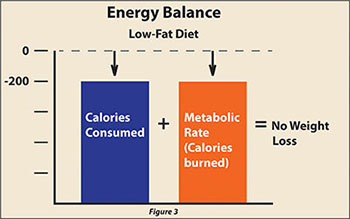
Figure 3
In order to keep losing weight, you need to reduce the number of calories you eat even more (Figure 4).
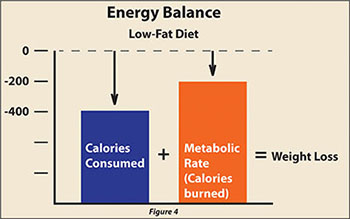
Figure 4
However, in response to the reduced calorie intake, your metabolism slows down even more to maintain an energy balance (Figure 5).
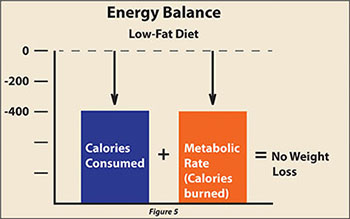
Figure 5
This process continues as long as you remain on the diet. You can reduce the amount of food you eat to starvation levels and still not lose any weight (Figure 6).
As you continue with the diet you must struggle with constant hunger and temptation. It takes a lot of willpower and effort to be successful. At some point, you are going to end the diet. You can't remain on this type of diet forever because not only is it uncomfortable, it is unhealthy and can lead to malnutrition and poor health.
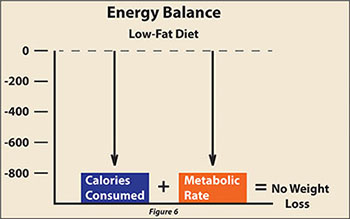
Figure 6
When you start adding a little more food into your diet, your calorie intake increases but your metabolism remains depressed (Figure 7). The result is weight gain. Over time you will gradually relax your food restrictions and eat more.
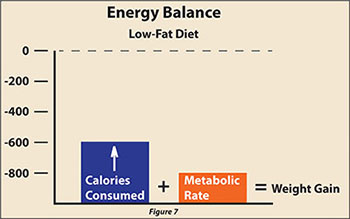
Figure 7
When your body realizes that the famine is over, your metabolism will gradually speed up (Figure 8).
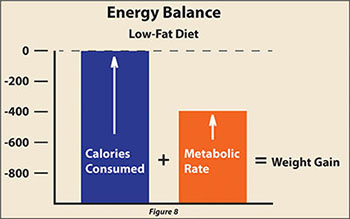
Figure 8
In time, your calorie intake and metabolism will return to the levels they were before you started the diet (Figure 9). Since it takes some time for your metabolism to recover, by the time it normalizes, you have not only regained all your lost weight but generally a few extra pounds as well. The end result is that you are heavier now than before you started the diet. This cycle may take 6 months to complete or it may take 5 years. As noted by researchers at the Mayo Clinic, 95 percent of dieters
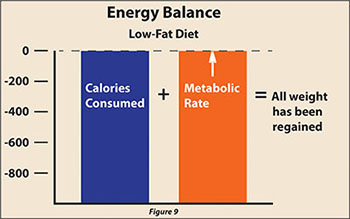
Figure 9
regain
all their weight within 5 years. This is why low-fat diets are
doomed to failure from the very start.
Since the diet didn't work, you may go on
another diet, ending with the same result and then another and another.
Each time you diet you get bigger and bigger. While the type of food you
eat does influence body weight, it can be the dieting itself that is the
biggest contributor to your weight problem.
All low-fat diets promote diet induced obesity.
Over the years, there have been various twists to the standard low-fat
diet, you have the cabbage soup diet, grapefruit diet, macrobiotic diet,
lemonade diet, the 3-hour diet, Beverly Hills diet, volumetrics, liquid
diets, and on and on. If the low-fat approach to dieting worked, why the
need for so many diets? The simple truth is they don't work, not in the
long run anyway.
Albert Einstein defined insanity as, "Doing the same thing over and over again but expecting a different result." We have tried low-fat dieting over and over again with the same result. No matter what name you put on it, to keep trying low-fat diets over and over is insane!
The reason why low-fat diets do not work is
because they do not include enough fat. Fat is the secret ingredient to
successful dieting. Believe it or not, fat is the ideal weight loss aid!
When a calorie reduced diet includes an ample
amount of fat, your metabolism does not change much. It remains elevated
as if you were eating full meals. Our ancestors had to survive in times
of winter and famine when food was scarce. The game they managed to
catch didn't provide them with much fat because the animals were lean
due to the general lack of food. During the summer, when food was
abundant, their game provided a rich source of fat and our ancestors'
metabolism remained high. The presence of fat in your diet tells the
body that food is abundant and that the hunting is good, there is no
famine.
When you go on a high-fat, calorie restricted diet your
metabolism stays normal. You can reduce calorie slightly and loose weight
the entire time you are on the diet (Figure 10). As long as you continue to
eat a healthy portion of fat, you metabolism will remain normal. Unlike a
low-fat diet, you are not forced to keep reducing your calorie intake time
and time again to keep losing weight. Another advantage of eating fat is
that it helps satisfy hunger. You don't experience the agonizing hunger
pangs you would with severe calorie restriction. It is almost like a
non-diet diet. When your weight loss goal is reached and you begin to eat
more calories, you do not experience weight gain because your metabolism was
never depressed (Figure 11). Instead of gaining weight, you simply stop
losing it.
Compared to a low-fat diet, a high-fat calorie
restricted diet is a breeze and ultimately much more successful. If you
continue to eat sensibly, your weight will stay off.
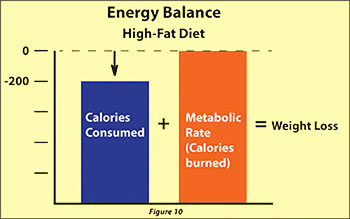
Figure 10
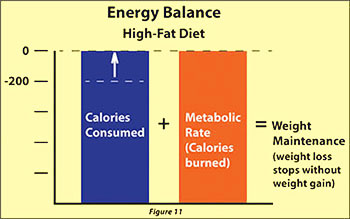
Figure 11

by Dr. Bruce Fife
Weight loss can be enhanced even further by
using coconut oil as your primary source of fat. Coconut oil, more than
any other fat, stimulates metabolism, thus helping to keep metabolism
elevated during the diet.
In order to take advantage of the metabolic
advantage of fat, you need to incorporate an ample amount into your
diet. Adding a couple of teaspoons of fat won't do a thing. You need to
let the body know that food is abundant and the hunting is good. This
means adding the equivalent of 3, 4, 5 or more tablespoons of fat,
preferably coconut oil, into your diet.
The ideal weight loss diet is a reduced calorie
ketogenic diet, especially a coconut ketogenic diet, where coconut oil
provides the primary source of fat. Fat satisfies hunger and can
actually help you feel full on less food. You can add the needed fat,
reduce total calorie intake, and still eat fully satisfying meals
without experiencing the hunger associated with low-fat diets. That's
one of the marvelous effects of a ketogenic diet.
To learn more about weight loss using a ketogenic approach I recommend
reading my book The Coconut Ketogenic Diet. See the amazing keto diet
transformation at
http://cocoketodiet.com/?page_id=373.
♦
Cures for Nail Fungus
A
troublesome old disease has reared its ugly head and is spreading like
wildfire. Since 1990 the number of new cases has tripled. Ten percent of the
population is already affected and the problem is expected to get worse.
Diet and lifestyle choices are believed to be contributing factors.
It is notoriously difficult to treat and usually does not resolve on
its own. Treatment, which can last up to a year, is only successful in about
60 percent of cases and even then, recurrence rates are high. The disease
develops slowly without any sign of warning. You might be infected right now
without realizing it.
What is
this hideous disease? It's a fungal infection that attacks the finger and
toenails. Doctors call it onychomycosis. It is commonly known as nail
fungus. While it is not a critical disease, it is unsightly and
embarrassing, can be irritating, and can trigger more infections in other
parts of the body.
The infection is caused by various fungal
organisms, most often dermatophytes of the genus Trichophyton. Another
common organism is Candida. Treatment takes time because the infection is embedded deep within the nail and in the
nail bed, making it nearly impossible for medications to reach. The old
infected nail must be completely replaced by healthy new growth before
medication can be discontinued. It takes about a year for the big toe to
completely grow a nail.
You can be infected without knowing it. The infection usually causes no pain and creeps up so slowly that the minute changes that occur each day go unnoticed until the nail is seriously affected. The infection causes thickening, discoloration, and separation from the nail bed. The normally clear nail turns various shades of white, black, or yellow. There may be scaly skin next to the nail, some itching, and a foul smell. Strong foot odor is a sign that a fungal infection may be present. As
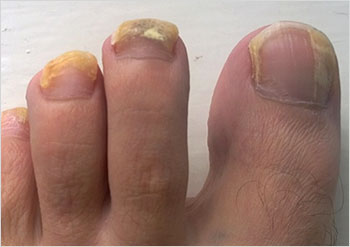
Photo credit: Dandandandandandandan2014
Nail fungus could be a sign of other health problems.
At best,
topical medications are only 17% effective, and recurrence rates are
high.
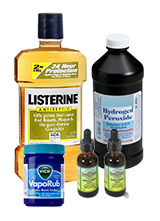
There are other,
potentially more effective, options.
the infection
progresses, the nail may become brittle, with pieces flaking or breaking
off. If left untreated, the skin can become inflamed and painful around
the nail. Generally there is no pain unless the disease is severe.
The unsightly appearance of the nails often
causes embarrassment and those who are affected tend to habitually hide
their feet from view, which may compound the problem. Fungi thrive in
warm, dark, moist places and wearing shoes for extended periods of time
creates such an environment.
Your risk of developing nail fungus increases
with age, heavy perspiration, living in a humid or moist environment,
having psoriasis, wearing socks and shoes that hinder ventilation or do
not absorb perspiration, being diabetic or having circulation problems,
having a weakened immune system, having minor skin or nail injuries, and
having other fungal infections such as athlete's foot or candidiasis.
The infection is contagious and can spread to others, however, if they
don't have any of these risk factors then infection is much less likely.
Nail fungus could be a sign of other health
problems which you might not be aware such as diabetes, atherosclerosis,
systemic fungal infection like candidiasis, or low immune function.
About one-third of those with diabetes also have nail fungus. This is
because they have poor circulation and the immune system is unable to
effectively protect the toes and feet from infections.
Approximately half of these people who visit the
doctor with suspect nail fungus are actually not infected but have only
nail deformities. For this reason, a medical diagnosis should be
confirmed before starting any drug-based treatment. Drugs used to treat
nail fungus are expensive and are often accompanied by some serious side
effects.
Treatment can be topical or oral. Common topical
medications include ciclopirox, amorolfine, and efinaconazole. These
medications need to be used daily for at least a year. Cicloprox has a
cure rate of 6-9 percent, amorolfine about the same, and efinaconazole
up to 17 percent. As you see, the cure rate for topical medications is
dismal. For this reason, doctors only recommend topical treatment for
mild to moderate cases, or when oral treatment is unsuitable due to
adverse side effects.
Cost is another issue. One tiny bottle of
efinaconazole (trade name Jublia)
contains only 4 ml. That is less than a teaspoon. The cost is a
whopping $539! The instructions in Jublia call for one drop per nail
each day. A 4 ml bottle contains about 80 drops. If the big toe is
affected, it gets two drops. If you have a big toe and two other toes
affected you would need four drops a day. One 4 ml bottle would last you
less than three weeks. But the treatment isn't over yet, at this point,
you are just getting started. The recommended duration of treatment is
at least 48 weeks, or nearly a year. That means you will need 16 of
those tiny bottles for complete treatment, costing a total of $8,624.
Nail fungus is an annoying problem and if paying this price would cure
the disease, it might be worth it, but it has only a 17 percent chance
of working.
Oral treatment is more effective. Oral
medications include terbinafine (76 percent effective), itraconazole (63
percent) and fluconazole (48 percent). Possible side effects include
diarrhea, stomach upset, fever, body aches, chills, difficulty
breathing, headaches, joint pain, nasal congestion, insomnia, fatigue,
hearing loss, irregular heartbeat, depression, and liver damage.
Treatment typically lasts for about 3 months. Recurrence occurs in up to
50 percent of cases.
These standard treatment options don't look too
promising, fortunately, there are cheaper, safer, and more effective
alternative treatments. Home remedies that have reportedly been used
with some success include Listerine, vinegar, hydrogen peroxide, garlic,
oregano oil, eucalyptus oil, snakeroot extract, tea tree oil, and Vicks
VapoRub.
Listerine mouthwash kills germs and since it is
used in the mouth, it's obviously safe enough to use on your feet. Its
antiseptic power comes from antimicrobial compounds as well as alcohol.
To treat toenail fungus an equal amount of Listerine is combined with
water and placed in a small tub. The infected feet are soaked in the
water for 30 to 50 minutes daily until the condition is resolved.
White vinegar is also highly antiseptic. Use the
same process of soaking the feet for 30 to 50 minutes using a mixture of
half vinegar and half water. Some people combine Listerine with vinegar
and reduce or eliminate the water.
People have sworn that these methods greatly
improved their condition. But there is some question, was it due to the
Listerine or vinegar or was it because soaking the feet daily required
them to wash and dry their feet allowing the body to cure itself
naturally? Washing the feet regularly is recommended for any nail fungus
treatment. It just makes sense to remove potentially troublesome germs
that could feed the infection by keeping the feet clean and dry.
The drawback to both of these methods is the
time commitment—30 to 50 minutes every day for what could be many
months. Another antiseptic that can be used is hydrogen peroxide. In
this case, you would soak a cotton ball in hydrogen peroxide and rub it
over the infected area. I would still recommend washing the feet before
applying the hydrogen peroxide, but the entire process takes only takes
a few minutes.
To my knowledge, these methods have not been
evaluated scientifically to prove their effectiveness on nail fungus.
Likewise, garlic, oregano oil, and eucalyptus oil possess antimicrobial
properties but I could find no studies that evaluated their effect on
nail fungus. Snakeroot extract, tea tree oil, and Vicks VapoRub, on the
other hand, have been scientifically tested for this condition.
Snakeroot (Ageratina pichinchensis) is member of
the sunflower family and is used as a traditional Mexican treatment for
superficial fungal infections. The extract has proven antifungal
properties, which has led researchers to explore its use as a topical
treatment for nail fungus. Studies have shown that snakeroot extract is
equally as effective as the topical antifungal medication ciclopirox.2
This isn't too impressive since ciclopirox is only 6-9 percent
effective.
Tea tree oil has proven useful in treating
various types of fungal infections such as athlete's foot and ringworm.
For example, Australia researchers took 158 people with athlete's food
and treated them with a placebo, a 25 percent tea tree oil solution, or
a 50 percent tea tree oil solution. The treatment was applied twice
daily for 4 weeks. The results showed that the two tea tree oil
solutions were substantially more effective than the placebo. In the 50
percent tea tree oil group, 64 percent were cured; in the 25 percent tea
tree oil group, 55 percent were cured of their athlete's foot.3
Because of studies like this, tea tree oil has
been suggested as a possible treatment for toenail fungus. The general
recommendation is to mix a few drops of tea tree oil with a teaspoon or
so of a carrier oil, such as olive or coconut oil, and apply it to the
infected nail. This process is repeated daily until the condition
clears. Anecdotal accounts indicate that this process might work, but
studies have been mixed.
A study carried out at the University of
Rochester, New York, compared the effectiveness of tea tree oil with
that of clotrimazole. Clotrimazole is a general purpose antifungal used
to treat vaginal yeast infections, athlete's foot, jock itch and similar
conditions. It is not as commonly used for nail fungus. The participants
were divided into two groups. One group used a 1 percent clotrimazole
solution while the other group used 100 percent tea tree oil.
After 6 months of therapy the two treatment groups reported
similar success rates with the tea tree oil coming in a little ahead.
The cure rate in the clotrimazole group was 11 percent compared to 18
percent in the tea tree group.4 An 18 percent cure rate is
just as good as the prescription medication efinaconazole (Jublia), but
it was applied at full strength without dilution. At this strength, tea
tree oil can cause skin irritation and contact dermatitis.
A diluted solution, mixed with a
carrier oil, may still be effective without the risk of irritation.
A second study reported by researchers at the
University of California, San Francisco evaluated a cream containing 5
percent tea tree oil as the active ingredient. The cream was applied
three times daily for 8 weeks. The cream was found to have no effect on
nail fungus.5 Why the difference in the two studies? There
are a couple of possible reasons: (1) the investigators only use a 5
percent preparation so it may have been too dilute to have any
substantial effect (2) the study only lasted 8 weeks, perhaps not
allowing enough time for a fair evaluation since most topical treatments
last for 48 or more weeks.
Surprisingly, one of the most effective home
remedies is Vicks VapoRub, an ointment used to sooth sore muscles.
Actually, the use of this product should not seem too unusual, seeing
that the active ingredients include thymol, menthol, camphor, and oil of
eucalyptus—all of which possess antifungal properties and have shown in
lab studies to be effective against dermatophytes, the most common type
of nail fungus. Without much scientific evidence Vicks VapoRub has been
publicize as a cure for nail fungus in the popular literature. As a
consequence, a study published in the
Journal of the American Board of
Family Medicine put VapoRub to the test. The study involved 18
participants with diagnosed active nail fungus. Participants were
instructed to apply VapoRub to the infected area at least once daily.
After 48 weeks of treatment, 28 percent were cured, 56 percent had
partial clearance, and 17 percent had no improvement.6
The 28 percent cure rate is better than the most effective
topical prescription medication efinaconazole (17 percent) and better
than the positive tests using 100 percent tea tree oil (18 percent). But
still, a 28 percent cure rate is not all that encouraging.

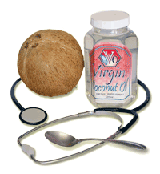
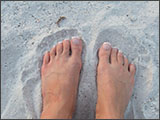
Dr. Joseph Mercola, DO writes that he was
troubled by nail fungus for nearly 20 years without relief. This was at
a time when he did not fully understand the importance of an optimal
diet and was running many thousands of miles. "It only finally resolved
when I wasn't even trying to get rid of it," he says. "I noticed that my
infection disappeared after frequent, daily doses of sunshine on my
toes. It makes perfect sense since UVB is a very potent germicidal, it
was clearly responsible for removing the infection that dozens of
previous approaches had failed miserably at. I do believe that regular,
ideally daily, exposures for many months are required for this to work.
Going out a few days a month will not be enough to treat this resistant
infection. One could likely use a tanning bed or UVB lamp to get the
same results."
I recommend exposing infected nails to direct
mid-day sunlight for at least 15 minutes a day. You need to do this
outside and not in your house behind the window. Glass blocks much of
the UV rays that kill the fungus. Mid-day sunlight is more intense and
more effective than at any other time of day. During the winter the
sun's rays are less intense, so this process is less effective at that
time. A tanning bed or UVB lamp might be a suitable option during this
time.
Another highly effective, natural, inexpensive
remedy is coconut oil. The medium chain fatty acids in coconut oil also
possess potent antifungal properties. While no studies have yet
evaluated the effectiveness of coconut oil in treating nail infections,
studies do show that the topical application of coconut oil is effective
in killing dermatophytes—the type of fungi that cause nail infections.7
Pure coconut oil, without any additional ingredients, has helped many
people overcome nail fungus when all other forms of treatment, natural
and pharmaceutical, have failed. One of the reasons why coconut oil
works better than many other topical treatments may be because it easily
penetrates the skin and is absorbed into the root of the nail where new
growth occurs.
A reader from Lake Elsinore, CA writes: "I
started using virgin coconut oil (VCO) to de-frizz my hair. Over the
holidays, my aunt complimented my long shiny hair, and I told her my
secret. I found out she is an avid VCO user too. She went on, and on
about the many health benefits I hadn't heard of. She mentioned that it
cured her athlete's foot. I had tried everything on my athlete's foot,
and nothing ever worked. I gave it a shot, and it worked!!!! The nail
fungi is completely gone!! It is now the only product I use on my skin
head to toe, it even got rid of my acne!!...Apparently, this stuff does
much more than de-frizz hair!"
Monica says, "My doctor had me mix a concoction
of coconut oil with oregano oil (from the health food store). I was
skeptical as I had fungus in toenails for decades. Completely cleared up
within 6 months!"
When Kerry was struggling with a chronic Candida
infection she also developed toenail fungus. Her doctor prescribed
antifungal medications. "The Doctor recommended Loceryl ointment with a
treatment time period of anywhere between 6-12 months." Says Kerry. "I
was a little horrified at the thought, but gave it a go for at least 3
months. The treatments are not cheap and in my opinion, and experience,
don't work. I also tried Canesten same process, same result—Zero. So at
this point, I'd lost 1 large toenail and was in the process of losing
the other one; I decided to try coconut oil. Why didn't I opt for this
in the first place, you may be asking? Mainly because I really believed
that a chemical based treatment would work faster and therefore, saving
my nail at a much quicker rate. Once I'd come to terms with the fact
that the pharmacy treatments were all the same and were not going to
work, it was easy to deal with the fact that the coconut oil would take
just as long but my hope was that it would work. In actual fact, the
coconut oil treatment only took approximately 3 months in total."
John, a 64-year-old diabetic, reports that the
dry, fungus infected skin all over his body was replaced by new healthy
skin by eating coconut oil. "After three weeks of use, I notice these
changes: My flaky, achy, dry skin is gone! My stinky scalp psoriasis is
also gone! My 4-inch diameter patch of itchy, scaly skin on my back is
gone! My wrinkled, square-shaped fingers are now rounded and smooth
looking as well as to the touch. My dry toe nails which were cracking,
breaking off, and dying are now regenerating! I have a whole new skin
that looks healthy and alive!"
John's story is interesting in that he did not
apply the oil to his infected skin or nails but simply ingested it. John
has diabetes, which can seriously affect circulation. Diabetics have a
high incidence of nail fungus because they have poor circulation in
their hands and feet. Peripheral neuropathy, characterized by the loss
of feeling in the feet and toes, is one of the most common symptoms
associated with diabetes. Atherosclerosis, or hardening of the arteries,
is also a common effect of diabetes, it too hampers blood flow in the
body. Consuming coconut oil regularly can greatly improve circulation to
the extremities reversing diabetic neuropathy and allow blood access to
the infected toes and nails. Coconut oil also kills Candida and other
fungi that can cause systemic and local infections. In addition, it
boosts the efficiency of the immune system in general, thus allowing the
body to be better able to fight off infections.
If you have diabetes, atherosclerosis,
candidiasis, or chronic low immune function, no drug or natural ointment
will cure your nail fungus, because they don't address these problems.
You must attack the problem internally. Consuming coconut oil is the
only remedy that can address all of these issues.
Whichever treatment you choose, you should
always try to keep your feet clean and dry. If your feet have a tendency
to sweat, wear shoes that allow your feet to breath. Wear a new pair of
socks at least daily and more often if they tend to get damp. Take your
shoes off whenever possible. If you have an active fungal infection,
make sure to wash your feet at the end of every day using soap and
water. Dry them off and expose them to the air. Rubbing a little
hydrogen peroxide on the infected area might also be beneficial.
The nail fungus thrives in the dead tissue of
the toenail. It makes sense that if you cut or trim the nails regularly
you will reduce the amount of fungus present, which may make getting rid
of it a little easier. Keeping the nails trimmed has proven beneficial.
A study published in the Journal
of the American Podiatric Medical Association showed that
participants who trimmed their infected toenails while taking oral
medication had a higher cure rate than those who did not trim their
nails.8
If you have a stubborn case of nail fungus, I
recommend the following four-step protocol:
(1) Wash
your feet and change your socks daily and expose your feet to fresh air
whenever possible. Use footwear that allows your feet to breath.
(2) Apply
a coat of coconut oil to the infected nail twice daily, once in the
morning and again, after washing, in the evening. You can combine the
coconut oil with a little tea tree oil; about 5-10 drops of tea tree oil
per 1 teaspoon (5 ml) of coconut oil.
(3) Expose
the infected nail to direct sunlight for at least 15 minutes a day.
During the winter or if you just can't find the time to do this during
the early afternoon, try a tanning salon or use a UVB lamp. Early
morning and late afternoon sunshine is generally not intense enough
except during mid-summer or if you live near the topics.
(4)
Make sure to add coconut oil into your daily diet, between 2-4
tablespoons (30-60 ml) daily. This is especially important if you have
diabetes, atherosclerosis, candidiasis, or chronic low immune function.
Continue to follow these steps until you feel
the infection is under control. Keep in mind that although the nail
bed—the skin underneath the nail—may improve in appearance, the infected
nail will always remain thickened and discolored even after the
infection is gone. So you have to wait until you can see new, healthy
nail growth at the base of the nail. Even then, it is a good idea to
continue with these steps for awhile longer to make sure the infection
is completely eradicated.
References
-
Westerberg, DP and Voyack, MJ. Onychomycosis: current trends in diagnosis and treatment. Am Fam Physician 2013;88:762-770.
-
Romero-Cerecero O, et al. Double-blind clinical trial for evaluating the effectiveness and tolerability of Ageratina pichinchensis extract on patients with mild to moderate onychomycosis. Planta Med 2008;74:1430-1435.
-
Satchell, AC, et al. Treatment of interdigital tinea pedis with 25% and 50% tea tree oil solution: a randomized, placebo-controlled, blinded study. Australas J Dermatol 2002;43:175-178.
-
Buck DS, Nidorf DM, Addino JG. Comparison of two topical preparations for the treatment of onychomycosis: Melaleuca alternifolia (tea tree) oil and clotrimazole. J Fam Pract. 1994;38(6):601-605.
-
Syed, TA, et al. Treatment of toenail onychomycosis with 2% butenafine and 5% Melaleuca alternifolia (tea tree) oil in cream. Trop Med Int Health 1999;4:284-287.
-
Derby R, et al. Novel treatment of onychomycosis using over-the-counter mentholated ointment: a clinical case series. J Am Board Fam Med. 2011;24(1):69-74.
-
Garg, AP and Miiller, J. Inhibition of growth of dermatophytes by Indian hair oils. Mycoses 1992;35:363-368.
-
Jennings MB, et al. Treatment of toenail onychomycosis with oral terbinafine plus aggressive debridement: IRON-CLAD, a large, randomized, open-label, multicenter trial. J Am Podiatr Med Assoc. 2006;96(6):465-473.
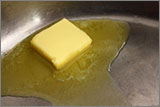
Butter
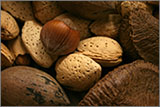
Nuts
Avacados
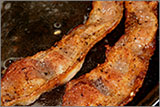
Bacon
There Should Be No Dietary Limit on
Fat Intake, Says
Researchers
We've been warned about the dangers of eating too much fat and cholesterol for years, and as a result have been avoiding them like the plague. This blind avoidance of fat, however, may have brought on a plague, a plague of increasing poor health and obesity. Scientists are now beginning to change their minds about fat. The theory that saturated fats and cholesterol cause heart disease has now been clearly disproven. The belief that fats and fatty foods promote obesity is now being seriously challenged. After years of study, fats are being exonerated from wrongdoing and the real culprit is coming to light—carbohydrates.
As warnings about the dangers of fat and cholesterol were loudly proclaimed, people cut back on fat and fatty foods, replacing them with lower fat carbohydrates. The results have been disastrous. Many health problems like diabetes, dementia, and obesity have greatly increased and heart disease still remains our number one killer.
A recent paper published in the Journal of the American Medical Association,1 co-authors Dariush Mozaffarian, MD, dean of the Friedman School of Nutrition Science and Policy at Tufts University, and David Ludwig, MD, director of the New Balance Foundation Obesity Prevention Center at Boston Children's Hospital, argue that we should stop worrying about the amount of fat and cholesterol in our diet and worry more about the amount and type of carbohydrates we eat.
The co-authors explain that growing evidence shows that eating foods that contain healthy fats can actually protect us against certain diseases, such as heart disease, while many low-fat and fat-free foods — like fat-free salad dressing and baked potato chips — may be worse for us nutritionally than full-fat options.
They also point out that for decades, carbohydrates were considered the foundation of a healthy diet, but research has shown that refined carbohydrates are linked to obesity. A 2010 study of nearly 54,000 people published in the American Journal of Clinical Nutrition found that refined carbohydrates is even worse for our health than saturated fat.2
Every 5 years, the US Department of Agriculture and Department of Health and Human Services jointly release the Dietary Guidelines for Americans. These guidelines have far-reaching influences across the food supply, including for schools, government cafeterias, the military, food assistance programs, agricultural production, restaurants, and industry food formulations. An accurate revision of the Dietary Guidelines is crucial to the health of millions of people. The Dietary Guidelines Advisory Committee (DGAC), a group of scientists appointed to systematically review the literature and provide evidence-based recommendations to the secretaries of Agriculture and Health and Human Services recently completed their report. In the coming months, the secretaries will review the DGAC recommendations; consider comments from the public, academics, advocacy groups, and industry; and finalize the Dietary Guidelines.
In the new DGAC report, one widely noticed revision was the elimination of dietary cholesterol as a "nutrient of concern." The new report places no restriction on cholesterol intake. This surprised the public, but is in line with recent scientific evidence showing no relationship between cholesterol consumption and cardiovascular disease.
A less noticeable, but more important, change was the absence of an upper limit on total fat consumption. The DGAC report neither listed total fat as a nutrient of concern nor proposed restricting its consumption. Rather, it concluded, "Reducing total fat (replacing total fat with overall carbohydrates) does not lower CVD [cardiovascular disease] risk...Dietary advice should put the emphasis on optimizing types of dietary fat and not reducing total fat."
Limiting total fat was also not recommended for obesity prevention; instead, the focus was placed on healthful food-based diet patterns that include more vegetables, fruits, whole grains, seafood, legumes, and dairy products and include less meats, sugar-sweetened foods and drinks, and refined grains.
This revised position by the DGAC reverses nearly 4 decades of nutrition advice and policy that placed priority on reducing total fat consumption throughout the population. In 1980, the Dietary Guidelines recommended limiting dietary fat to less than 30% of calories. This recommendation was revised in 2005, to include a range from 20% to 35% of calories. The primary rationale for limiting total fat was to lower saturated fat and dietary cholesterol, which were thought to increase cardiovascular risk by raising low-density lipoprotein cholesterol. But the campaign against saturated fat quickly generalized to include all dietary fat. Because fat contains about twice the calories per gram as carbohydrate or protein, it was also reasoned that low-fat diets would help prevent obesity.
The complex relationship between saturated fat and blood cholesterol is now better understood than it was 30 years ago. Several types of cholesterol have been identified, each influencing risk of heart disease differently, which invalidates any generalized statement about the risks of total cholesterol. Total cholesterol level is meaningless in terms of predicting cardiovascular risk. You must know which types of cholesterol make up that total for any meaningful prediction. Blood levels of high-density lipoproteins (HDL cholesterol) and large low-density lipoproteins (LDL cholesterol), which are increased by saturated fat consumption, are now known to protect against heart disease. Carbohydrates, however, increase blood levels of small, dense LDL cholesterol and triglycerides, both of which increase the risk.
Limiting total fat consumption inevitably increase carbohydrate consumption and consequently, increases the risk of heart disease as well as obesity, diabetes, Alzheimer's, and many other degenerative diseases.
For decades, carbohydrates were considered a foundation of a healthful diet and formed the foundation of the Food Guide Pyramid released in 1992. However, by 2005, the Dietary Guidelines recommended restricting refined grains and added sugars due to growing evidence that refined carbohydrates increase metabolic dysfunction, obesity, and cardiovascular disease.
Recommendations from the committee will go on to the U.S. Department of Agriculture and the U.S. Department of Health and Human Services, which will write the final Dietary Guidelines for Americans. ♦
References
-
Mozaffarian, D. and Ludwig, DS. The 2015 US Dietary Guidelines lifting the ban on total dietary fat. JAMA 2015;313:2421-2422.
-
Jakobsen, MU, et al. Intake of carbohydrates compared with intake of saturated fatty acids and the risk of myocardial infarction: importance of the glycemic index. Am J Clin Nutr 2010;91:1764-1768.
New!
The Coconut Oil Miracle, 5th
Edition audiobook
is now available
For years The Coconut Oil Miracle has been a reliable guide for better health. Now in its fifth edition, this updated and expanded version has even more information on the benefits of coconut oil
and is now available in audiobook format, so you can play it in
your car or MP3 player. A total of 7.5 hours.
.
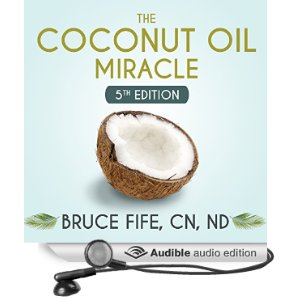
Do you have friends who would like this newsletter? If so, please feel free to share this newsletter with them.
If this newsletter was forwarded to you by a friend and you would like to subscribe, click here.
Copyright © 2015, Bruce Fife. All rights reserved.